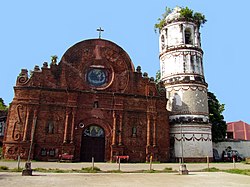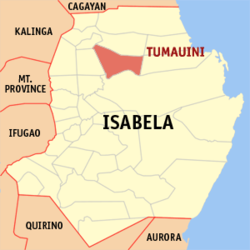Tumauini
| Tumauini | ||
|---|---|---|
| Municipality | ||

Façade of St. Mathias Parish Church
|
||
|
||
 Map of Isabela showing the location of Tumauini |
||
| Location within the Philippines | ||
| Coordinates: 17°16′N 121°48′E / 17.27°N 121.8°ECoordinates: 17°16′N 121°48′E / 17.27°N 121.8°E | ||
| Country | Philippines | |
| Region | Cagayan Valley (Region II) | |
| Province | Isabela | |
| District | 1st District of Isabela | |
| Founded | 1751 | |
| Barangays | 46 | |
| Government | ||
| • Mayor | Arnold S. Bautista | |
| • Vice Mayor | Lorenzo Uy Jr. | |
| • Electorate | 37,884 voters (2016 election) | |
| Area | ||
| • Total | 467.30 km2 (180.43 sq mi) | |
| Population (2015 census) | ||
| • Total | 67,650 | |
| • Rank | 200th of 1,489 Municipalities | |
| • Density | 140/km2 (370/sq mi) | |
| Time zone | PST (UTC+8) | |
| ZIP code | 3325 | |
| 023137000 | ||
| IDD : area code | +63 (0)78 | |
| Income class | 1st municipal income class | |
| Revenue | ₱ 25,891,570.41 (2016) | |
| Poverty incidence | 20.34 (2012) | |
| Website | www |
|
Tumauiniis a 1st class municipality in the province of Isabela, Philippines. According to the 2015 census, it has a population of 67,650 people.
Tumauini is located at the northern portion of the province of Isabela. Its land area is 46,730 hectares (115,500 acres) or 5.62% of the total land area of Isabela. It is bounded on the north by the municipality of Cabagan and 68 kilometres (42 mi) south from Tuguegarao (the Regional Center); on the east by the municipality of Divilacan, on the south by the City of Ilagan, the capital of Isabela (30 kilometres (19 mi) away) and 445 kilometres (277 mi) north from Manila; on the west by the Cagayan River and the municipality of Delfin Albano.
Tumauini is politically subdivided into 46 barangays. Four (4) of which compose the center of the city whereas the other forty two (42) are in the outlying areas. Some of them are even several kilometers away from the center of the municipality. The most populous are Sisim Abajo, Fugu Sur, Sinippil, Santa Catalina, Tunggui, Lalauanan, San Vicente, Malamag East, Barangay District 2 (Pob.), Fugu Norte, Banig, Malamag West, Barangay District 4 (Pob.), Fugu Abajo, Barangay District 1 (Pob.).
The name of Tumauini originated from the name of the big trees found in the poblacion called "Mauini". It is said that when some Spaniard wanted to know the name of the trees, they asked a native saying, "Como se llama el grande lenia? Sabes tu?" The native not knowing what the Spaniards said, picked the last word he heard and answered "Tumauini".
In 1952, the barrios of Barucbuc, Siempre Viva, Bimmonton, Pasurgong, Manga, and Settlement No. 1 were transferred to the newly created town of Mallig.
In 1957, the barrios of San Antonio, San Juan, Ragan Sur, Ragan Norte, Ragan Almacen, San Jose (Bulo), San Patricio, Quibal, San Andres (Lattu), Calinawan Sur, Bayabo, Santor, Sto. Rosario, Andarayan, Aneg, San Isidro, Mawi, San Roque, Carmencita, Aga, Villa Pareda, Villaluz, San Pedro, Concepcion, Sammabario and San Nicolas and the sitios of Turod, Paco, Calamagui and Kim-malabasa, were separated from the municipality of Tumauini to form the town of Magsaysay. Camp Samal used to be the camp of guerillas in 1945 world war II, and Camp Samal had been also used by the Filipino American troops against the Japanese invasion, and SAMAL derives from SA means Sadornas, and MAL from Malana.
...
Wikipedia


